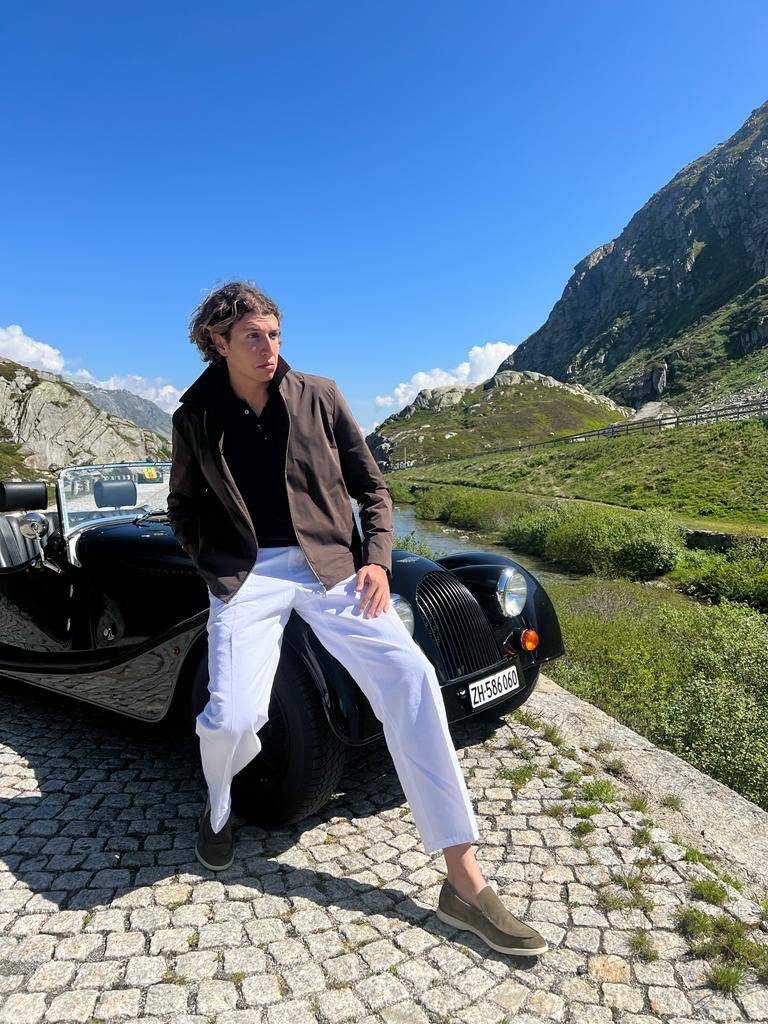
Gstaad Guy — who keeps his real identity a secret — began making a name for himself only a few years ago in niche social media circles by parodying the lives and tastes of the ultra-rich through sharp, satirical social commentary delivered through fictional personas: mainstay character Constance, an old-money British aristocrat who peppers his conversations with French and Italian and dresses head-to-toe in LVMH’s “quiet luxury” bastion brand Loro Piana, and guest-star Colton, a happy-go-lucky, nouveau-riche Gen-Z American. His humour is carefully targeted: many of Constance’s quips will sail far above the heads of the average Joe or Jane, but leave 1 percent of the wealthy, who are used to flitting between Gstaad, Monaco and London, chortling. (According to Forbes, a good chunk of its Billionaires List is among his following.)
Equally, luxury fashion brands also get where Gstaad Guy is coming from — to the extent that several have entered into partnerships with the social media star. Loro Piana launched 600 limited editions of its Open Knitted Walk shoes exclusively for Gstaad Guy followers; the collaboration sold out within hours and became the fastest-selling product the brand had ever made, according to Forbes.
BoF: How did Gstaad Guy come about?
Gstaad Guy: I was Facetiming [with] a close friend of mine, who has a place in Gstaad. He was complaining about something he shouldn’t be complaining about. I had never been there at the time, but I knew a lot of things about it purely based on conversations with him. I filmed one video on Snapchat, making fun of things I’ve heard him say, while really dialling up the absurdity. I sent that video to his mum, all in character, this fictional character I coined Constance, inspired by my friend. His family and closest friends found the video hilarious. His mum sent it to all the Gstaad mums’ WhatsApp group chats, which went to different parents and students of the Le Rosey boarding school [in Switzerland]. And it then quickly trickled into Gstaad-frequenting Geneva, Monaco and London communities.
My satirical social commentary would focus on things that are only really relatable to very few in Gstaad, Monaco, Geneva and Mayfair [in London]. By video five, I think I had maybe 4,000 followers, I spoke about how Constance loves his Loro Piana vicuña gilet. A couple of weeks later, I was told by the salesperson at Loro Piana on Sloane Street that people have been coming into the store asking to buy the items I was wearing in my video. And all similar gilets had sold out.
I was accidentally selling dozens of products that cost about three grand, with under 5,000 followers. This has never been done before; I knew it because I’ve been on the other side. [I thought] there’s really something here.
BoF: What is it about Gstaad Guy that attracts your target audience?
GG: I was making fun of a place that’s very inconvenient to access through commercial means of transport. It is three hours away from any commercial airport. And it’s, frankly, too expensive and too quiet for someone to just stumble upon. So through travel inconvenience, unaffordability and the privacy of the Swiss mountains, Gstaad just attracts some of the world’s wealthiest people -— people that commute between their chalets in Gstaad, townhouses in London, chateaux in Saint-Tropez and boats on the Mediterranean. And because I was making jokes about them and the way they live their lives there, I was attracting them.
BoF: In this influencer landscape that is so saturated, what’s the white space that you occupy?
GG: I am in a very unique position, where I have, through fiction, created very authentic characters. People have a deep connection with the characters, likely because of how authentic to their values they are. Especially Constance.
And because of the rather niche jokes I’m making. I have the highest concentration today of high-net-worth people of any social media page globally, who are being communicated things that are delivered lightly through tongue-in-cheek storytelling that’s very digestible.
BoF: What has your Gstaad Guy account led to in terms of business opportunities?
GG: Gstaad Guy is an atypical account. With anything atypical, especially in the luxury world, you don’t sell it like you sell commodities. It’s not, ‘Hey, here’s my price, buy or leave it and move on.’ That’s bad for the buyer and the seller. In the world of luxury social-media marketing, selling ad space and having a very authentic partnership are two very different things.
For Gstaad Guy, I always had to have a “tasting” for my potential clients before they hired me as their chef. And the way I always played that game is: who is Gstaad Guy in real life? What are the products and items that he would actually love? And let me just talk about those things more and more. I never thought I would have the scale to convert the masses of voyeurs. And I still don’t think I do. But I know I have the storytelling abilities to convert and elevate customers of an existing brand to new, better products, and to an elevated perception of that brand.
Slowly, through storytelling, I built a really strong connection with my audience around a very few, very high-end products, which are historically very difficult to market, and it gave the brands no choice but to work with me. I became their ambassador before they asked me to. I think that’s what every brand is looking for now. Ad space is readily available, but authentic connections with an audience are scarce. If you have the choice, who are you going to choose? Obviously, the person who has the most authentic connection with your brand and ideal customers, so it doesn’t seem like an ad in your face.

BoF: Historically, luxury has been very protective of the way that brands are communicated. Content poking fun at their top customer base was not something that they would have typically engaged with. What’s changed?
GG: I think the only thing that’s changed is that it’s been digitised. If you look at the real conversion of top clients around a truly luxurious brand like Loro Piana, it was never happening in a magazine or on a billboard. It was always happening at a dinner table, among friends and like-minded people. And the way the items were discussed was always through a passion for excellence [and] often through the delivery of comedy and relaxed nonchalance, as one does at a group dinner.
If you’re smart and you’ve made enough money to afford this stuff, you know that luxury is often ridiculous by design. Of course, the brands can’t say that, but the people at the dinner table can, and that’s happened for generations. … A brand can talk about their excellences and about how and why they create, but … as a consumer, you don’t want to feel like you’re being sold something [and] during those off-the-record moments where the founders of the brands can talk to friends and to ideal customers, they can add that salt and pepper that makes it digestible, and that’s what I do. Digital salt and pepper.
BoF: What role do products play in your business, given that you are, first and foremost, creating content? There’s a lot of content that doesn’t have any reference necessarily to any products.
GG: Consumerism is so deeply integrated in the core of my archetypes’ personalities and desires. Their conversations are so often about products, and why this product is better than the other. It really came as second nature to my content and storytelling. From my very first video, when I never had any commercial intentions or ideas, Constance was talking about his favourite restaurants, destinations, clothes and Loro Piana gilet. It never seemed inauthentic; I wasn’t talking about the art of yoga and all of a sudden selling toothpaste. I’ve just been expressing who my characters are, and how their buying desires are all intrinsically linked to their values and interests. Real life connoisseurs like Constance demand excellence in all categories of their lives, regardless of price, and if it isn’t excellent, it’s à la poubelle.
BoF: Is that limiting the number of brands you can work with?
GG: Absolutely, and I think that’s a great thing. I don’t want to become a walking billboard. I’d rather be authentic to the few things I love personally and the few things my characters love. Just like the real Gstaad Guy types. Constance isn’t fickle and he very rarely changes his shopping, travel or dining habits.
BoF: In your case, scale almost works against you because you want to speak to a small community. How do you think about this as you become more famous?
GG: The world’s obsession with scale is a bad one, and I learned that the hard way when I worked on a start-up before this. I raised a lot of money and all my investors said is, “scale, scale, scale,” and we ended up with two million users that we could not convert financially. If I had raised far less venture money instead, and had 300,000 users who were paying, that’s a much better position to be in. And then scale those paying customers very, very slowly and make something sustainable.
That’s the core of luxury. If you have few people who love your products and you just grow that sustainably, you can remain a luxury brand and you can get your customers on the ladder of slow elevation. That’s really my ideal scenario — to continue to elevate the storytelling, elevate the product offering. … I intentionally stay away from a lot of viral moments on social media because that’s not me. I’ll sometimes use my Gen-Z hypebeast character Colton to provide contrast and perspective. But Constance, the Gstaad Guy, is not fashion. He’s not a trend. Gstaad Guy is a constant. I don’t want him to give in to trends, I don’t want him to give in to fashion, because I want him to be timeless, that’s how Gstaad Guy is perceived.
This interview has been edited and condensed.
This article first appeared in The State of Fashion 2024, an in-depth report on the global fashion industry, co-published by BoF and McKinsey & Company.
Disclosure: LVMH is part of a group of investors who, together, hold a minority interest in The Business of Fashion. All investors have signed shareholders’ documentation guaranteeing BoF’s complete editorial independence.



